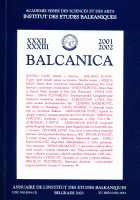Beleške o Glasincu
Notes on Glasinac
Author(s): Rastko VasićSubject(s): Archaeology
Published by: Balkanološki institut - Srpska akademija nauka i umetnosti
Keywords: Glasinac; Balkans; prehistoric sites;
Summary/Abstract: Glasinac, the plain east of Sarajevo, with thousands of burial mounds and hundreds of hillforts, represents one of cult prehistoric sites in the Balkans, which even after 120 years of intensive work and research has failed to provide adequate solutions to all the problems present. The first excavations at Glasinac were carried out in 1880, under the supervision of lieutenant engineer J. Lexsa, and the subsequent ones in 1886 under the management of captains F. Glossauer and J. Brudl. On establishing the National Museum in Sarajevo, the systematic research in Glasinac (1888-1897) started, conducted by C. Truhelka, D. Stratimirovic and F. Fiala. Between World War I and World War II there was some minor work carried out under M. Mandić (1937), while after World War II Glasinac was studied by B. Čović (1957) and B. Govedarica (from 1974 until 1990, intermittently). In addition to reports from these excavations, several books and studies on this subject were published by M. Hoernes, A. Benac, B. Čović, M. Garasanin, N. Lucentini, etc. The main topic of these considerations was the chronology of Glasinac material. At first it was predominantly thought to be Hallstatt; eventually, owing primarily to the work of A. Benac and B. Čović, it was established that the cultural development on the Glasinac Plain was continuous from the beginning of the Bronze Age until Late Iron Age. Benac and Covic gave also the basic chronological division of the archeological material into five phases, Glasinac I – V, which is, with some additional changes in certain types, still applied today. In spite of the wealth of studies and papers on Glasinac and its material, a great deal is as yet unstudied and unknown. More accurately, the researched material has not been published in its entirety; in the summary stating of the discovered material there are still a lot of unknown and unidentified pieces that can provide valuable information; detailed analyses of certain forms and periods are still lacking. Those are the reasons for the objective of this paper to be an attempt for the Glasinac material to be regionally analyzed, and to establish what differences, if any, are present in the cultural development of certain parts of the Glasinac Plain, or the area that this name is applied to in archeological literature. The name Glasinac Plain refers to the area east of Sarajevo, around Sokolac, but this geographic name was applied to the areas north, east and south of the Plain, where prehistoric burial mounds were excavated, not only in the close vicinity, but even the burial mounds in the village of Strpci near Priboj, some 70 km away from Glasinac. Such a review of Glasinac sites, even though it may be summary, showed that Glasinac cannot be observed as one single organism functioning regularly and steadily, as it may appear on the surface, when observing its chronological phases and typological tables. The picture is actually essentially different.
Journal: BALCANICA
- Issue Year: 2001
- Issue No: 32+33
- Page Range: 7-30
- Page Count: 30
- Language: Serbian

